Lecture 31: Trees
In this lecture, we will study trees:
Basic Definition
Properties of Trees with some proofs.
Pruefer Sequences: Representing and Counting Labelled Trees using Clayley's Theorem.
If time permits, counting rooted/unlabelled trees using Catalan Numbers.
Trees
You have most probably studied rooted trees and binary search trees as a data-structure for organizing lists of numbers and efficiently performing insertions and deletions. However a tree is a useful structure in many other parts of CS:
Game trees in AI (how can we make computers play games like chess, go,…).
Decision trees in ML.
Spanning trees in network routing.
Parse trees for compilers.
The list goes on and on
Tree (definition)
Let us start with the simplest kind of trees: unrooted and undirected trees.
A (unrooted) tree  is an undirected graph
is an undirected graph  such that
such that
 is fully connected (the entire graph is a maximally connected component),
is fully connected (the entire graph is a maximally connected component),  is acyclic (there are no cycles in
is acyclic (there are no cycles in  ).
).
A rooted tree  is a fully connected, acyclic graph with a special
node
is a fully connected, acyclic graph with a special
node  that is called the root of the tree. You may have
studied rooted trees in your data structures class. With a root, it is
possible to define a parent and children for each node. But
without a root, we will regard the tree simply as a connected, acyclic
graph.
that is called the root of the tree. You may have
studied rooted trees in your data structures class. With a root, it is
possible to define a parent and children for each node. But
without a root, we will regard the tree simply as a connected, acyclic
graph.
Examples
Here are some examples of unrooted trees:
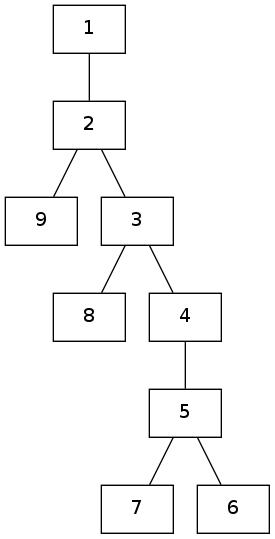
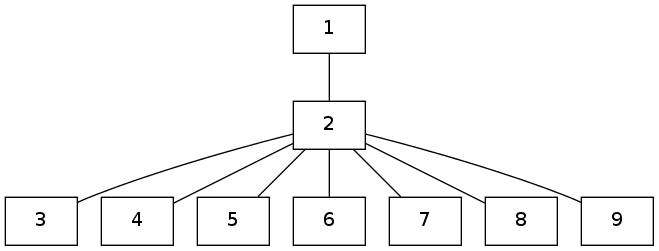
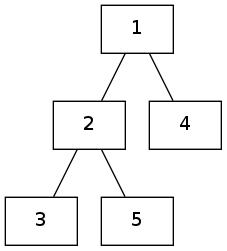
Non-Examples
The following graph is not a tree. It has a cycle:
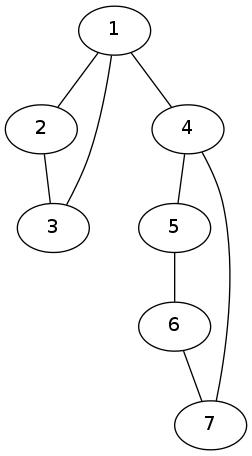
Here is another example that has more than one maximal connected components and is not a tree:
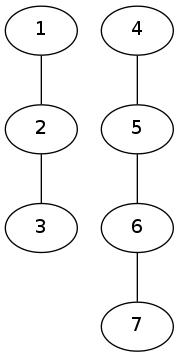
Properties of Trees
Leaves of a Tree
A leaf of an unrooted tree is a node that has a degree  .
Let us write down the leaves of the following tree examples:
.
Let us write down the leaves of the following tree examples:

Leaves are  .
.

Leaves are  .
.

Leaves are  .
.
Claim Every tree has a leaf.
If the tree just has one node, then it is trivially a leaf. If the tree has two nodes connected by an edge, both nodes are leaves. Let us focus on trees with three or more nodes.
Let us assume that a tree  that does not have a leaf exists.
Therefore for every node
that does not have a leaf exists.
Therefore for every node  in this tree
in this tree  .
We are going to show that
.
We are going to show that  has a cycle, yielding a contradiction
with the assumption that it is a tree.
has a cycle, yielding a contradiction
with the assumption that it is a tree.
Start from any node  in the tree and do a walk as follows:
in the tree and do a walk as follows:
Take any edge out for
 to reach
to reach  .
. For any node
 , take an edge other than the
, take an edge other than the  that we took to enter
that we took to enter  . Since
. Since  , such a vertex is always available.
, such a vertex is always available.
Note that the walk above can be continued for arbitrarily many steps. However, since number of vertices is finite, the walk repeats a vertex. Let for some  ,
,
 . We can now conclude the existence of a cycle with
. We can now conclude the existence of a cycle with  in it. Therefore
in it. Therefore  is not a tree, yielding a contradiction.
is not a tree, yielding a contradiction.
Thus, we have concluded that every tree has a leaf.
Number of Edges
Claim A tree with  nodes has
nodes has  edges.
edges.
Proof is by weak induction on the number of nodes  .
.
Base Case: Take any tree with  node. There is just one such tree
and it has
node. There is just one such tree
and it has  edges.
edges.
Inductive Hypothesis: Let us assume that all trees with  nodes have
nodes have  edges. We will show that all trees with
edges. We will show that all trees with  nodes have
nodes have  edges.
edges.
Take some tree  with
with  nodes. It must have a leaf
nodes. It must have a leaf  . Removing the leaf gives us a tree with
. Removing the leaf gives us a tree with  nodes that must have
nodes that must have  edges in it.
The leaf itself was connected to the rest of the tree by one edge. Therefore
edges in it.
The leaf itself was connected to the rest of the tree by one edge. Therefore  has
has  edges.
edges.
Number of Leaves
Claim Any tree has at least two leaves.
We will prove this in class by the following argument. We already know that any tree has at least one leaf.
Let us assume that there is a tree with  nodes and exactly one leaf
nodes and exactly one leaf  .
.
Therefore all nodes other than
 have degree
have degree  .
. Sum of degrees of all nodes
 .
. However, we know that sum of degrees of all nodes = 2 * number of edges.
number of edges
 .
. However a tree has precisely
 edges.
edges. This leads to a contradiction.
Paths in Trees
Claim Let  and
and  be two nodes in a tree. There is precisely one path from
be two nodes in a tree. There is precisely one path from  to
to  in the tree.
in the tree.
Argument in class Since the tree is connected component itself, there has to be at least one path from  to
to  .
.
We will argue that having two distinct paths will necessarily imply that the tree has a cycle which will lead to a contradiction.
Counting Labeled Trees and Pruefer Sequences
We will now present a very elegant method of representing labeled trees and count them using Pruefer sequences.
Labelled vs. Unlabelled Trees
We distinguish between instances of trees where the names of the vertices matter and instances where all that matters are the connection between vertices. The former class of trees are called labelled trees and the latter are called unlabelled trees.
Take the following three trees:
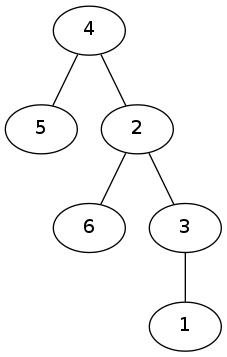
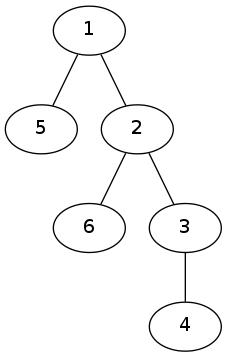
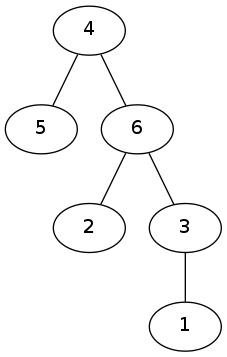
They have the same number of nodes and are ‘‘isomorphic+ to each other. The tree on the left is obtained by substituting  with
with  everywhere. Similarly the tree on the right is obtained by substituting
everywhere. Similarly the tree on the right is obtained by substituting  with
with  for the tree in the middle.
for the tree in the middle.
| Trees | Isomorphism |
| 1 vs. 2 | 1 <-> 4 |
| 2 vs. 3 | 2 <-> 6 |
| 1 vs. 3 | 1 <-> 4, 2 <-> 6 |
We can view a tree in two ways:
Labelled Tree: The labels on the nodes actually matter and two isomorphic trees with different labels are actually different trees. In particular, the above example represents different labelled trees.
Unlabelled Trees: The labels do not matter. Isomorphic trees count as the same. In particular, all trees in the above example are the same.
All the examples above represent the following unlabelled tree:
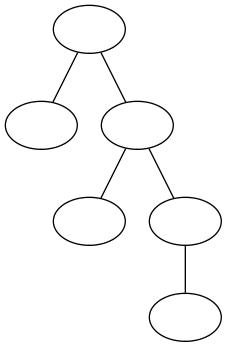
Pruffer Sequences
Given a labelled tree  , we can represent it by a sequence of numbers called its Pruefer Sequence or its Pruefer Code.
Let us assume that the labels for the nodes
of the tree are numbers from
, we can represent it by a sequence of numbers called its Pruefer Sequence or its Pruefer Code.
Let us assume that the labels for the nodes
of the tree are numbers from  to
to  .
.
Basic idea behind a Pruefer Sequence is to keep removing the leaves one at a time and write down a number corresponding to each leaf that we remove:
Take the lowest numbered leaf in the tree and remove it.
Add the number of the node the removed leaf is connected to the Pruefer sequence.
Repeat until just two vertices remain.
Example
Let us write down the Pruffer sequence for this tree:

To start with, the smallest numbered leaf is  . We remove
. We remove  from the tree and add
from the tree and add  to the Pruefer sequence. We get the tree:
to the Pruefer sequence. We get the tree:
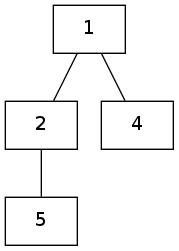
The smallest number leaf is now  , which is connected to
, which is connected to  . We add
. We add  to the Pruefer sequence, to get the tree:
to the Pruefer sequence, to get the tree:

The smallest numbered leaf is a  , which is connected to
, which is connected to  . Therefore, we add
. Therefore, we add  to the Pruefer sequence.
to the Pruefer sequence.
To complete out the process, we get the Pruefer sequence: 2,1,2
Example-2
Let us try other trees and write down their Pruefer sequences.

The Pruefer sequence is  .
.
Example-3

The Pruefer sequence is  .
.
Reconstructing Trees From Pruefer Code
Let us now figure out what a valid Pruefer Sequence is and how to reconstruct a tree uniquely from its Pruefer Sequence.
Pruefer Sequences
For a tree with  nodes assumed to be labelled
nodes assumed to be labelled  , its Pruefer sequence has
, its Pruefer sequence has
 numbers in the sequence.
numbers in the sequence. Each number can be from
 .
. In fact, any sequence of
 numbers from
numbers from  is possible.
is possible.
Reconstruction Algorithm: Example
Let us try and reconstruct a tree from its given Pruefer sequence: 
Q1 How many nodes does the tree have? 9.
The algorithm looks at the smallest number that we have not yet seen so far in the Pruefer sequence.
The smallest number that does not appear so far in the sequence is a
 .
. Therefore we conclude that
 must be the first leaf removed and that it is connected to a
must be the first leaf removed and that it is connected to a  .
.
The remaining sequence is  . We remember that
. We remember that  has been resolved:
has been resolved:  .
.
The smallest number that does not appear is
 .
. Therefore, we conclude that
 must have been a leaf at this stage and is connected to
must have been a leaf at this stage and is connected to  .
.
The remaining sequence is  . We remember that
. We remember that  have been resolved:
have been resolved:  .
.
Smallest number is a
 and it must be connected to a
and it must be connected to a  .
.
The remaining sequence is  . We remember that
. We remember that  have been resolved
have been resolved  .
.
Smallest number is a
 and it must be connected to a
and it must be connected to a  .
.
The remaining sequence is  .
.  resolved and
resolved and 
Here is the complete run of the algorithm
| Remaining Sequence | Resolved Nodes | Smallest number not seen so far | Edge Inferred | |
| 2,5,5,4,3,3,2 | - | 1 | (2,1), (1,2) | |
| 5,5,4,3,3,2 | 1 | 6 | (6,5), (5,6) | |
| 5,4,3,3,2 | 1,6 | 7 | (5,7), (7,5) | |
| 4,3,3,2 | 1,6,7 | 5 | (5,4), (4,5) | |
| 3,3,2 | 1,5,6,7 | 4 | (4,3), (3,4) | |
| 3,2 | 1,4,5,6,7 | 8 | (8,3), (3,8) | |
| 2 | 1,4,5,6,7,8 | 3 | (3,2), (2,3) | |
 | 1,3,4,5,6,7,8 | - | (2,9), (9,2) |
The last step is special since we have two nodes unseen, the Pruefer sequence is exhausted and we conclude that they must form an edge.
Clayley's Formula
There are exactly  distinct labelled trees on
distinct labelled trees on  nodes.
nodes.